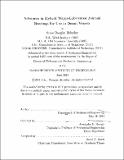| dc.contributor.advisor | Alexander H. Slocum. | en_US |
| dc.contributor.author | Heberley, Brian Douglas | en_US |
| dc.contributor.other | Massachusetts Institute of Technology. Department of Mechanical Engineering. | en_US |
| dc.date.accessioned | 2013-10-24T18:13:17Z | |
| dc.date.available | 2013-10-24T18:13:17Z | |
| dc.date.copyright | 2013 | en_US |
| dc.date.issued | 2013 | en_US |
| dc.identifier.uri | http://hdl.handle.net/1721.1/81753 | |
| dc.description | Thesis (Ph. D.)--Massachusetts Institute of Technology, Dept. of Mechanical Engineering, 2013. | en_US |
| dc.description | This electronic version was submitted by the student author. The certified thesis is available in the Institute Archives and Special Collections. | en_US |
| dc.description | Cataloged from student-submitted PDF version of thesis. | en_US |
| dc.description | Includes bibliographical references (p. 439-441). | en_US |
| dc.description.abstract | The outboard bearings that support shafts in naval ships and submarines present unique challenges to designers, shipbuilders, and operators. Such bearings must operate continuously and reliably in demanding environments at speeds that vary from below 1 rpm to well over 100 rpm. Water-lubricated bearings typically used for these applications operate hydrodynamically and are prone to adverse effects at lower speeds such as increased abrasive and adhesive wear as well as stick-slip shaft motion. This project focuses on developing a hybrid journal bearing capable of operating with hydrostatic pump pressure at lower rpm, while still maintaining the capability for hydrodynamic operation at higher rpm. Benefits of such a system include extending the periodicity between outboard bearing replacements, less abrasion and scoring damage to the propulsion shaft, and preventing stick-slip shaft motion. To enable the in-water replacement of bearings without removal of the propulsion shaft, a partial arc (<180 degree wrap) configuration is required. This partial arc constraint introduces several unique manufacturing difficulties. To address this, a novel manufacturing process has been developed that enables the rapid fabrication of high precision bearings with diameter and roundness errors of less than 0.001" (25.4 microns) on a nominal diameter of 3.24" as measured with a Coordinate Measuring Machine - greatly exceeding the published tolerances of conventional methods. A unique experimental test rig was designed and built in order to measure the performance of 15 different prototype bearing designs. The rig is capable of submerged bearing testing in both hydrostatic and hydrodynamic modes of operation, with fundamental parameters such as speed, torque, loads, pressures, flow rates, and shaft position recorded. The operating characteristics of the bearings were then analyzed to identify key features and variables affecting bearing performance. Certain bearing designs were found to be inherently stable for side loading conditions, without the use of compensation typically used in hydrostatic bearings. This finding led to bearings designed with simplified hydrostatic features and fluid supply systems. Such designs were found to have minimal degradation in hydrodynamic performance, making them particularly suitable for use as hybrid bearings. The key design drivers identified in this work are combined with ancillary factors to discuss the feasibility of hybrid bearings for use in marine applications. | en_US |
| dc.description.statementofresponsibility | by Brian Douglas Heberley. | en_US |
| dc.format.extent | 441 p. | en_US |
| dc.language.iso | eng | en_US |
| dc.publisher | Massachusetts Institute of Technology | en_US |
| dc.rights | M.I.T. theses are protected by
copyright. They may be viewed from this source for any purpose, but
reproduction or distribution in any format is prohibited without written
permission. See provided URL for inquiries about permission. | en_US |
| dc.rights.uri | http://dspace.mit.edu/handle/1721.1/7582 | en_US |
| dc.subject | Mechanical Engineering. | en_US |
| dc.title | Advances in hybrid water-lubricated journal bearings for use in ocean vessels | en_US |
| dc.type | Thesis | en_US |
| dc.description.degree | Ph.D. | en_US |
| dc.contributor.department | Massachusetts Institute of Technology. Department of Mechanical Engineering | |
| dc.identifier.oclc | 860902486 | en_US |
